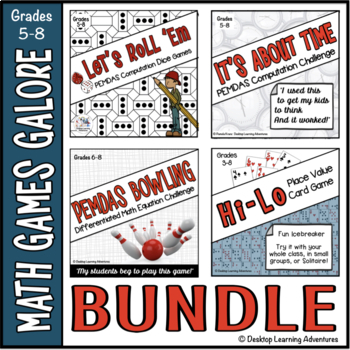PEMDAS Computation Math Games Galore Bundle - Differentiated
- Zip
Products in this Bundle (4)
Description
Math Games Galore Bundle is a collection of my favorite math strategy games. These year-round games are differentiated and accessible to students in 4th-8th grade. They work well in centers, as a solitaire activity when students are finished, as team challenges or homework (when you want students to have some meaningful practice).
Math Games Galore includes: PEMDAS Order of Operations Bowling Computation Game, Let's Roll 'Em, It's About Time- A PEMDAS Computation Activity, and Hi-Lo Place Value Game.
Each game/activity includes teacher notes, extension & differentiation ideas, and all student pages. Set up is quick and, other than running off student pages where needed, there's little prep work. Once students learn how to play the games, they make a great “Plan B” or a nice addition to your sub (guest teacher) folder.
Math Games Galore Bundle is a great way to build your Computation/Numeracy Math Games collection at a big savings over the price of the games sold separately in my store.
♥♥♥ For quick go-to, low prep activities, click HERE to check out Crack the Code puzzles. They're great practice and handy to have for those last-minute change of plans.
***************************************************************************
Customer Tips:
How to get TpT credit to use on future purchases:
Please go to your My Purchases page (you may need to login). Beside each purchase you’ll see a Provide Feedback button. Simply click it and you will be taken to a page where you can give a quick rating and leave a short comment for the product. Each time you give feedback, TpT gives you feedback credits that you use to lower the cost of your future purchases. I value your feedback greatly, as it helps me determine which products are most valuable for your classroom, so I can create more for you.
Be the first to know about my new discounts, freebies and product launches:
Look for the green star next to my store logo and click it to become a follower. Voila! You will now receive email updates about this store!
Thanks for stopping by! Pam Kranz
***************************************************************************
© Pamela Kranz Desktop Learning Adventures All Rights Reserved





